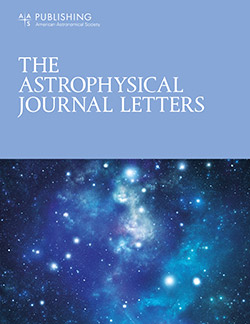Fast Radio Bursts: Electromagnetic Counterparts to Extreme Mass-ratio Inspirals
IF 8.8
1区 物理与天体物理
Q1 ASTRONOMY & ASTROPHYSICS
引用次数: 0
Abstract
Abstract Recent observations discovered that some repeating fast radio bursts (FRBs) show a large value and complex variations of Faraday rotation measures (RMs). The binary systems containing a supermassive black hole and a neutron star can be used to explain such RM variations. Meanwhile, such systems produce low-frequency gravitational-wave (GW) signals, which are one of the primary interests of three proposed space-based GW detectors: the Laser Interferometer Space Antenna (LISA), Tianqin, and Taiji. These signals are known as extreme mass-ratio inspirals (EMRIs). Therefore, FRBs can serve as candidates of electromagnetic counterparts for EMRI signals. In this Letter, we study the EMRI signals in this binary system, which can be detected up to z ∼ 0.04 by LISA and Tianqin for the most optimistic case. Assuming the cosmic comb model for FRB production, the total event rate can be as high as ∼1 Gpc −3 yr −1 . EMRI signals associated with FRBs can be used to reveal the progenitor of FRBs. It is also a new type of standard siren, which can be used as an independent cosmological probe.快速射电暴:电磁对应物的极端质量比吸气
最近的观测发现,一些重复快速射电暴(frb)表现出较大的法拉第旋转测量值(RMs)和复杂的变化。包含一个超大质量黑洞和一个中子星的双星系统可以用来解释这种RM变化。同时,这样的系统产生低频引力波(GW)信号,这是三个拟议的天基引力波探测器的主要兴趣之一:激光干涉仪空间天线(LISA),天琴和太极。这些信号被称为极端质量比吸气(EMRIs)。因此,frb可以作为EMRI信号的电磁对应物候选。在这篇论文中,我们研究了这个二元系统的EMRI信号,LISA和Tianqin在最乐观的情况下可以检测到z ~ 0.04。假设快速射电暴产生的宇宙梳模型,总事件率可以高达~ 1 Gpc−3 yr−1。与快速射电暴相关的EMRI信号可以用来揭示快速射电暴的起源。它也是一种新型的标准警笛,可以作为独立的宇宙探测器使用。
本文章由计算机程序翻译,如有差异,请以英文原文为准。
求助全文
约1分钟内获得全文
求助全文
来源期刊

Astrophysical Journal Letters
ASTRONOMY & ASTROPHYSICS-
CiteScore
14.10
自引率
6.30%
发文量
513
审稿时长
2-3 weeks
期刊介绍:
The Astrophysical Journal Letters (ApJL) is widely regarded as the foremost journal for swiftly disseminating groundbreaking astronomical research. It focuses on concise reports that highlight pivotal advancements in the field of astrophysics. By prioritizing timeliness and the generation of immediate interest among researchers, ApJL showcases articles featuring novel discoveries and critical findings that have a profound effect on the scientific community. Moreover, ApJL ensures that published articles are comprehensive in their scope, presenting context that can be readily comprehensible to scientists who may not possess expertise in the specific disciplines covered.
 求助内容:
求助内容: 应助结果提醒方式:
应助结果提醒方式:


